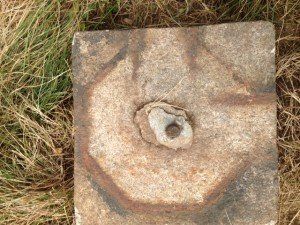Work Has Begun at the Mitchell Lot at Prospect Hill Cemetery!
It will take quite a bit of time but happily, on August 26th, the stone work was begun at the Prospect Hill Cemetery to restore the wrought iron fence at the Mitchell family lot where William and Lydia Mitchell, along with Maria, her oldest brother Andrew, her oldest sister Sally, and her aunt and namesake Maria Coleman are all buried. Neil Patterson and his crew will be re-setting the granite stones so that DeAngelis Ironwork of Boston can restore the wrought iron fence that once ringed the lot. It likely fell into disrepair in the early twentieth century and went for scrap metal, perhaps for the war effort. Many of the lots, if not all of them, were surrounded by fences at Prospect Hill.
Using a historic photo that was found in a Maria Mitchell scrapbook, we are restoring the fence to the best of our ability – the image is a little grainy and blurry so some details have been lost. This work is all funded by a Community Preservation Act grant that Jascin Leonardo Finger, Curator of the Mitchell House, Archives and Special Collections wrote for Fiscal Year 2013. The grant included restoration of the fence at the Hadwen lot at Prospect Hill, as well as the conservation of the wrought iron fence at the Coffin School on Winter Street. Since the same ironwork and stone masons would be used, a collaborative ask was created. For approximately a decade, the Mitchell House curator has been collaborating with Prospect Hill and its historian, Paula Lundy Levy, offering stone cleaning workshops for the public that illustrate hands-on how to properly clean historic gravestones. The restoration of the fences and the collaborative grant were a natural progression of their work together and long overdue – the family’s deserve to have their resting place restored to what it once was. Stay tuned as we bring you more information and images as the work progresses! And thank you, to the Community Preservation Committee, Neil Patterson and Crew, and DeAngelis Ironwork!
JNLF
Recent Posts






